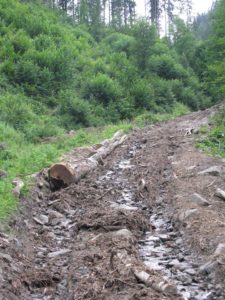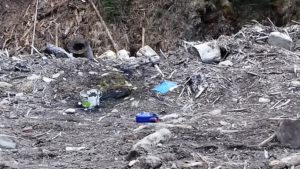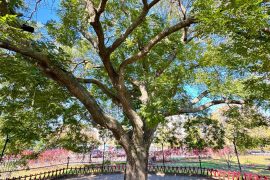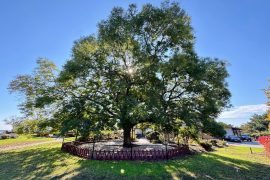At the end of the summer, Ecosphere held a seminar for those who love hiking or walking in the woods. Today, on Facebook, you can often come across emotional posts by users about illegal logging, illustrated by photos of logged areas. However, most of this information is in fact either fake, cases on Facebook are isolated cases; or uninformative, because the photographs taken make it difficult to discern any existing violations of environmental legislation that are often allowed by state forestry workers during logging. The same purpose of such seminars from Ecosphere NGO is to teach the indifferent residents of our region who willingly share their impressions about the events in the forest, distinguish illegal logging from the legal logging, as well as be able to see the offenses that may be on the entire legal forest.
In order to improve logging practices in state forestry, it is very important for the activity of citizens who can adequately and qualitatively respond to certain violations of the current environmental legislation revealed during the visit to the forest. Such citizens can be hikers and cyclists, mushroom and berry lovers, or village dwellers, who may be directly affected by violations of the rules and regulations for logging.
No professional knowledge is required to identify most systemic logging offenses related to the negative, and devastating environmental impacts that occur in our state forests. Everyone can recognize them. The most common offenses will be covered in this post.
The most common offense, which mainly concerns mountain state forestry, is driftwood. These streams are small forest streams and rivers, both permanent and temporary, which are used instead of forest roads during logging. Almost all mountain forestry enterprises are guilty of this, which causes irreparable damage. Firstly, to the fishery resources of the region. River skidding completely destroys the habitat of most aquatic organisms that serve as a feed base for fish, changing their species structure. Logs, trees, branches and bark that are often left in a broken channel affect the chemical composition of the water and the formation of sediment, making the spawning grounds for salmon and red carnivorous fish species downstream. Scientific studies of these phenomena prove that for the complete restoration of the river after such intervention during logging takes 10-15 years. And such interventions are daily and widespread throughout the Carpathians.



The violation is also the lack of bridges across rivers, which is also common in all forests. Through the rivers, timber is hauled for its preliminary storage in loading points (upper warehouses), which are located near the roads. It also causes extremely negative mechanical and hydrodynamic impacts on the river ecosystem, causes the breaking of water and changes in its chemical composition, in particular, due to the constant entry into the water of fuel and lubricants from skidding equipment. All this affects the overall water quality of the rivers at the top.




It is inadmissible to place loading points near the river bed. However, since the rivers in the mountains are, in most cases, used as forest roads, which skid timber (as mentioned above), the upper timber structures are located here as well. This practice has a very negative impact on water quality, because under such conditions fuel and lubricants get into the rivers, they are clogged with household waste, mainly plastic, and decomposition products. During heavy rainfall, the upper timber structures located near river beds can be a deadly risk to forestry workers in the logging area. With heavy rainfall, floods are formed very quickly and water can carry away the flow of stacked assortments of wood, damaging both people and technology.




Any forest management measures, including logging, should be carried out in ways that do not allow erosion processes and waterlogging of permanent and temporary watercourses. Unfortunately, forestry practice is different. In most cases, deep erosion processes of the soil in the forests, as well as the extreme siltation of the rivers, are the result of deforestation. The blockage of temporary water courses, as well as the erosion processes during heavy rains, cause significant erosion of soil, roads, mudflows, which are also dangerous for human life. Such events took place this year, for example, in the valley of the river Mokryanka.




Not infrequently, while traveling in the mountains, you can come across solid logs in spruce forests, which today suffer from drying out due to disease. This problem, which is widespread for our spruce trees, is due to the fact that spruce monocultures were planted once in place of beech and beech-fir forests. In the context of global warming on the planet, spruce monocultural forests are disease-resistant and require complete reformulation. Large areas of continuous logs should be planted with indigenous rocks, mainly deciduous. In some cases, this is exactly what happens. However, some of these logs in the forestry are left for self-renewal, and they are again overgrown with the same spruce, which will dry again without reaching technical maturity. Moreover, there are cases where such logging remains untreated, despite the fact that the remaining wood can serve as a source of propagation of the bark to neighboring areas.


There are not uncommon cases of sanitary felling during the “silence period”, which is the period of forest animal reproduction. This is a violation of sanitary rules in forests. The “Silence Period” runs from April 1 to June 15 and is an important period for vertebrates.
This whole block of forestry offenses has a very negative impact on the water resources of the region, on soils and exogenous processes in the mountains, on forest fauna. When you see any of the above, take a picture with your smartphone with geolocation enabled and post this information on Facebook. This information will help identify the forest area and respond quickly to such a violation. This way, everyone will be able to take part in constructive work to improve logging practices in the Carpathian forests.
Ecosphere NGO Press Office







